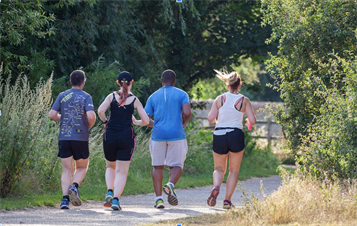Endurance Activities to Conquer Your Marathon Goals

As the popularity of marathons grows, so does the recognition of one key ingredient for success: endurance. It's the ability to sustain prolonged physical or mental effort, a critical component in long-distance running. Hence, build your endurance, whether running as a seasoned runner eyeing a new personal best or a newcomer with dreams of crossing your first finish line.
In this article, we discuss various endurance-building activities to prepare your body and mind for the demands of a marathon.
Endurance in Marathon Training
Endurance enables you to manage fatigue, resist pain, and push through mental barriers.
There are two primary types of endurance: aerobic and anaerobic. Aerobic endurance refers to your ability to perform moderate-intensity activities over extended periods by utilizing oxygen to generate energy.
On the other hand, anaerobic endurance involves your ability to perform high-intensity activities for short durations without relying on oxygen for energy production. Instead, your body uses energy sources stored directly in the muscles, which produces lactic acid as a byproduct.
Therefore, whether you are looking to get a roadbike for gravel cycling or adding long runs to your routine, balancing training to enhance both types of endurance can improve overall marathon performance. Below are activities to consider.
Core Endurance Activities for Marathon Training
Long Runs
Long runs are a staple in any marathon training program, typically involving a steady run at a relaxed pace. They develop aerobic endurance, enhance cardiovascular efficiency, and teach the body to burn fat as a fuel source, conserving glycogen reserves for the later stages of a race.
Additionally, long runs strengthen the musculoskeletal system and improve mental toughness, one of the psychological demands of marathon racing.
To increase your running distance safely, you can follow the 10% rule—never increase your weekly total mileage or the distance by more than 10% weekly. This gradual progression helps avoid injury and allows the body to adapt. Further, you can incorporate recovery weeks every 3-4 weeks, where mileage is reduced by 20-30%.
Interval Training
It involves alternating between periods of high-intensity effort and low-intensity recovery. Such training can improve aerobic and anaerobic fitness, increase cardiovascular efficiency, and boost calorie burn and metabolism. The high-intensity intervals push the body to adapt by improving the efficiency of the processes that convert oxygen and stored glycogen into energy.
A popular interval training workout for marathon preparation might include 400-meter repeats at a pace faster than the race pace with equal time or distance for recovery jogs. For example, you can run 8x400 meters with 400 meters of light jogging or walks in between. Another example could be ladder workouts, where distances and intensities vary, such as 400m, 800m, 1200m, 800m, and 400m intervals, each followed by equal time recovery periods.
Tempo Runs
Tempo runs, also known as threshold runs, require a comfortably hard pace that you can sustain for at least 20 minutes. The main benefit of tempo running is that it trains the body to sustain speed over distance.
You do this by increasing your lactate threshold, the point during intense exercise when lactate (a byproduct of glucose metabolism) accumulates in the bloodstream faster than you can eliminate it. This accumulation can lead to fatigue and a decrease in performance. For most runners, this threshold occurs at around 75-90% of their maximum heart rate.
As such, endurance training helps your body process and tolerate lactate more efficiently by running at or below your lactate threshold pace.
Incorporate tempo runs into a marathon training regimen once a week. Start with a warm-up of 10-15 minutes of easy running, then transition to 20 minutes at a tempo pace, and finish with a 10-minute cooldown. As fitness improves, the duration of the tempo portion can gradually increase up to 40 minutes or split into multiple segments with short rest intervals.
Supplementary Endurance Exercises
Cross-Training
Cross-training incorporates various forms of exercise other than running to improve overall fitness and endurance. For example, cycling uses the leg muscles in a low-impact way. As such, it improves cardiovascular endurance while giving the joints a break from the pounding they receive from running.
On the other hand, swimming is a total-body workout that enhances cardiovascular fitness and builds upper-body strength. It helps in recovery, as the buoyancy of the water supports the body and alleviates stress on all joints and muscles.
Strength Training
Strength training strengthens muscles and joints to absorb the impact of running better and maintain form even when you experience fatigue. It also helps improve your running economy, which is the amount of energy expended at a given pace, making running faster and less taxing.
Strength training exercises include lunges, squats, planks, bicycle crunches, and Russian twists.
Conclusion
Endurance activities are the cornerstone of successful marathon training, underpinning every step from the initial training phases to the race. These activities, ranging from long runs to interval and tempo workouts, enhance the physiological capacity needed for long-distance running and fortify mental resilience.
Furthermore, supplementary exercises like cross-training and strength training prevent overuse injuries by balancing muscle use and improving overall physical condition. Ultimately, engaging in these diverse endurance activities equips you with the stamina, speed, and strength to participate in a marathon.